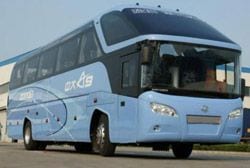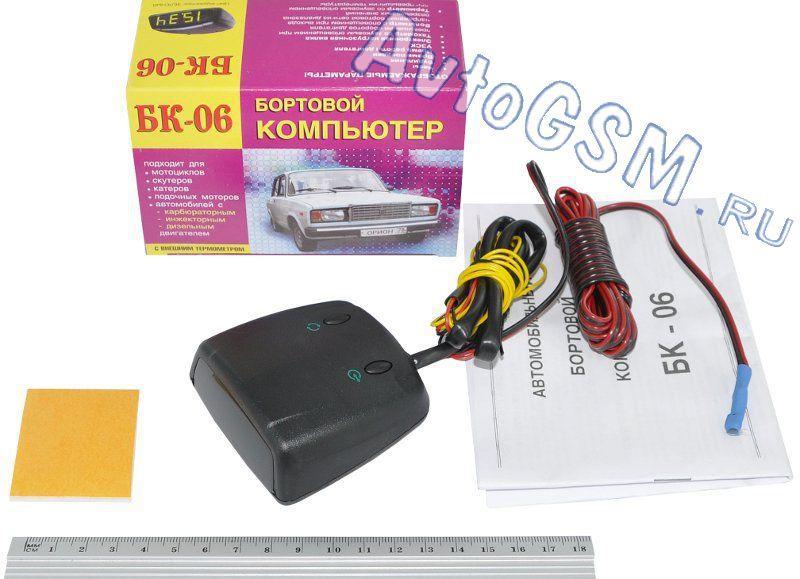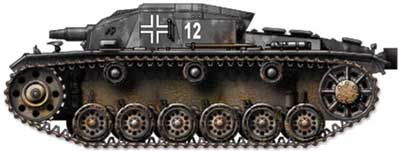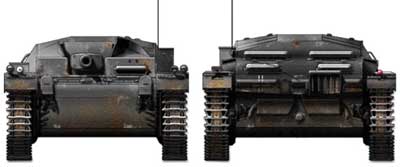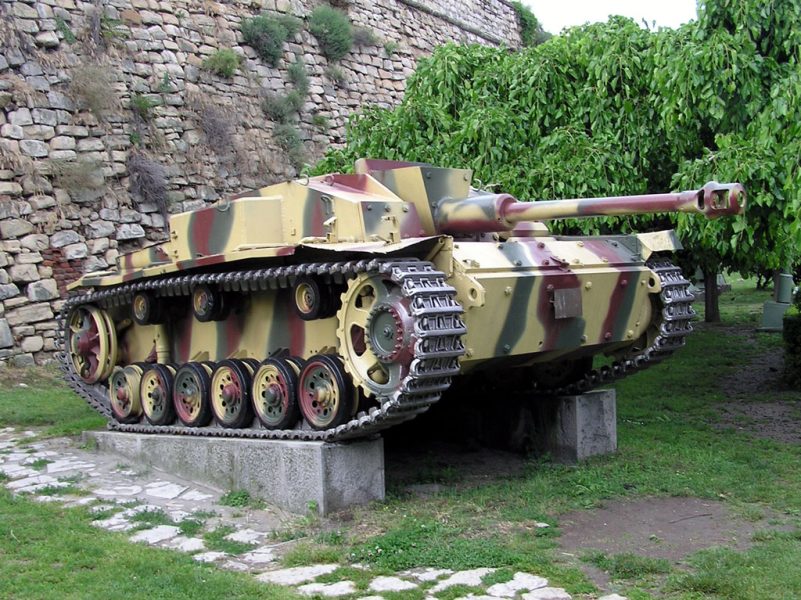
Assault gun I “Sturmgeschütz” III
Content
Assault gun I “Sturmgeschütz” IIIStuG III;
The assault gun was created by Daimler-Benz on the basis of the Pz-III (T-III) tank and was produced since 1940 as a means of direct infantry support. It differed from the tank in the absence of a turret. The 75-mm gun with a barrel length of 24 caliber was placed on a special machine in a spacious conning tower, mounted in front of the chassis, borrowed from the T-III tank with virtually no changes. A commander's cupola with viewing devices was installed on the roof of the cabin. The assault gun was equipped with a radio station, a tank intercom and a smoke exhaust system. During the serial production of the assault gun, it was repeatedly modernized both in terms of armament and armor protection. The thickness of the frontal armor was eventually increased from 15 mm to 80 mm. Armor screens were used to protect the sides. The short-barreled gun was replaced by a gun of the same caliber with a long barrel of 43 calibers, and then 48 calibers. The base of the assault gun was also used to mount a 105 mm howitzer with a 28,3 caliber barrel. Assault guns III entered service with assault gun brigades, tank regiments, and anti-tank units of infantry divisions. In total, during the production period, about 10,5 thousand III assault guns of various modifications were produced. The story behind the StuG IIILearn more about the history behind the Sturmgeschütz III The official contract for the development of the assault gun was issued on June 15, 1936.The contract stipulated the following technical requirements for the vehicle:
As stipulated by the specification, the top of the wheelhouse of the installation was carried out open, without a roof. In 1936, it was believed that an open top would provide additional tactical advantages: the crew gets a better view of the terrain than the crew of a tank and, in addition, can hear the sounds of the enemy's combat equipment. However, in 1939 it was decided to switch to a variant with a fully armored roof of the installation. The design with a closed top was the result of changed tactical requirements for an assault gun. The need for a roof was explained by the possible ricochet of bullets inside the fighting compartment, when the car was fired on descents or ascents. It was believed that the probability of hitting the top of the s.Pak installation on the move or in place by a direct hit by a mine or projectile is very low. The thin upper armor plate could not withstand a direct hit by an 81-mm mortar or a 75-mm high-explosive projectile, while at the same time it provided protection for the crew members from hand grenades. The roof of the fighting compartment was not waterproof and could not prevent the Molotov cocktail from getting inside the installation from the burning liquid. Already after the development of the roof structure, there was a requirement to ensure firing from a gun from closed positions, as a result, the project had to be somewhat redone. A hole was made in the roof for the optical head of the panoramic sight. The gunner was aiming the gun without seeing the target, he received the order about the angles of the sight from the commander of the battery. This method of shooting was used when firing from closed positions. The chassis of the PzKpfw III tank was chosen as the base. The first prototype of this tank, known as the "Zugfurerwagen" (platoon commander's vehicle) appeared at the end of 1935. After testing and modifications, the tank was put into serial production at the Daimler-Benz AG plant No. 40 in Berlin-Marisnfeld. From 1937 to 1939 The following series of PzKpfw III tanks were built:
Learn more about the history behind the Sturmgeschütz III Assault guns “0-series”Learn more about Series 0 Assault Weapons The first five assault guns of the “0-series” were made of ordinary structural steel based on the chassis of the PzKpfw III tanks of the 2nd series. Accurate records of production by the armaments department were not kept until December 1938, so it is very difficult to determine the period of time in which the 0-series assault guns were built. It is known that several companies were involved in their manufacture, in particular, Daimler-Benz supplied the chassis and cabins, and Krupp supplied the guns. The first three vehicles were assembled by December 1937, it is known that the chassis of the fourth and fifth vehicles were transferred to the 1st Tank Regiment in Erfurt on December 6, 1937. Data on that. when cuttings were made by Daimler-Benz are absent. There is a document dated September 30, 1936, which says: “four chassis of PzKpfw III tanks with wooden models of assault gun cabins should be prepared for testing in April-May 1937.” Assault guns of the “0-series” differed from the vehicles of later modifications mainly in the design of the undercarriage, which included eight road wheels, a drive wheel, a sloth and three rollers supporting the caterpillar on board. The track rollers were blocked in pairs into bogies, in turn, every two bogies were suspended on a common leaf spring: the movement of the bogies in the vertical plane was limited by rubberized stops. The sharp throws of carts when driving over rough terrain were partly damped by Fichtel und Sachs shock absorbers, which worked only when the cart was moving up. The caterpillar consisted of 121 tracks 360 mm wide (the distance between the fingers was 380 mm). A 12-cylinder carburetor V-shaped internal combustion engine “Maybach” HL108 was mounted in the rear of the case, the collapse of the cylinder blocks was 60 grams, the cast engine crankcase consisted of two parts, fastened with bolts. The lower part of the crankcase was an oil bath. The engine developed a power of 230 hp. at 2300 rpm The clutch, transmission and turning mechanism were located in front of the body in a single structural unit. The five-speed synchro-mechanical transmission "Afon" SFG-75 was developed and manufactured by "Sahnradfabrik Friedrichshafn" (ZF). The army received five “0-series” vehicles in September 1939, since the cuttings of the vehicles were made of ordinary steel, the combat use of prototype assault guns was excluded, they were used to train crews. Five experimental installations eventually ended up in the school of assault artillery in Juteborg, where they were used at least until the end of 1941. Learn more about Series 0 Assault Weapons Assault gun Ausf.A |
| Model | StuG III ausf.A-B |
| Military index | Sd.Kfz.142 |
| Manufacturer | "Daimler Benz" |
| Combat weight, kg | 19 600 |
| Crew | 4 |
Speed, km / h | |
| - by highway | 40 |
| - along the country road | 24 |
Power reserve, km | |
| - on the highway | 160 |
| - on the ground | 100 |
| Fuel tank capacity, l | 320 |
| Length, mm | 5 480 |
| Width | 2 950 |
| Height, mm | 1 950 |
| Clearance, mm | 385 |
| Track width, mm | 360 |
| Engine, firm | “Maybach” |
| Type | HL120TR |
| Power, hp | 300 |
| Weapon, type | StuK37 |
| Caliber, mm | 75 |
| Barrel length, cal, | 24 |
Early projectile speed, m / s | |
| - armor-piercing | 385 |
| - fragmentation | 420 |
| Ammunition, rds. | 44 |
| Machine guns, number x type *** | no |
| Caliber, mm | |
| Ammunition, cartridges | |
| Reservations, mm | 50-30 |
* - The length of the self-propelled guns with a barrel of 48 calibers
** - A number of StuG III ausf.E received a StuK lang gun with a 40 caliber barrel
*** - Assault guns and howitzers StuG 40, StuH 42 of later releases had a second machine gun coaxial with a cannon
ausf CD
| Model | StuG III ausf.CD |
| Military index | Sd.Kfz.142 |
| Manufacturer | "Alkett" |
| Combat weight, kg | 22 000 |
| Crew | 4 |
Speed, km / h | |
| - by highway | 40 |
| - along the country road | 24 |
Power reserve, km | |
| - on the highway | 160 |
| - on the ground | 100 |
| Fuel tank capacity, l | 320 |
| Length, mm | 5 500 |
| Width | 2 950 |
| Height, mm | 1 960 |
| Clearance, mm | 385 |
| Track width, mm | 380 – 400 |
| Engine, firm | “Maybach” |
| Type | HL120TRME |
| Power, hp | 300 |
| Weapon, type | StuK37 |
| Caliber, mm | 75 |
| Barrel length, cal, | 24 |
Early projectile speed, m / s | |
| - armor-piercing | 385 |
| - fragmentation | 420 |
| Ammunition, rds. | 44 |
| Machine guns, number x type *** | no |
| Caliber, mm | 7,92 |
| Ammunition, cartridges | 600 |
| Reservations, mm | 80 – 50 |
* - The length of the self-propelled guns with a barrel of 48 calibers
** - A number of StuG III ausf.E received a StuK lang gun with a 40 caliber barrel
*** - Assault guns and howitzers StuG 40, StuH 42 of later releases had a second machine gun coaxial with a cannon
outf E
| Model | StuG III ausf.E |
| Military index | Sd.Kfz.142 |
| Manufacturer | "Alkett" |
| Combat weight, kg | 22 050 |
| Crew | 4 |
Speed, km / h | |
| - by highway | 40 |
| - along the country road | 24 |
Power reserve, km | |
| - on the highway | 165 |
| - on the ground | 95 |
| Fuel tank capacity, l | 320 |
| Length, mm | 5 500 |
| Width | 2 950 |
| Height, mm | 1 960 |
| Clearance, mm | 385 |
| Track width, mm | 380 – 400 |
| Engine, firm | “Maybach” |
| Type | HL120TRME |
| Power, hp | 300 |
| Weapon, type | StuK37** |
| Caliber, mm | 75 |
| Barrel length, cal, | 24 |
Early projectile speed, m / s | |
| - armor-piercing | 385 |
| - fragmentation | 420 |
| Ammunition, rds. | 50 (54) |
| Machine guns, number x type *** | 1 x MG-34 |
| Caliber, mm | 7,92 |
| Ammunition, cartridges | 600 |
| Reservations, mm | 80 – 50 |
* - The length of the self-propelled guns with a barrel of 48 calibers
** - A number of StuG III ausf.E received a StuK lang gun with a 40 caliber barrel
*** - Assault guns and howitzers StuG 40, StuH 42 of later releases had a second machine gun coaxial with a cannon
execute F
| Model | StuG III ausf.F |
| Military index | Sd.Kfz.142 / 1 |
| Manufacturer | "Alkett" |
| Combat weight, kg | 23 200 |
| Crew | 4 |
Speed, km / h | |
| - by highway | 40 |
| - along the country road | 24 |
Power reserve, km | |
| - on the highway | 165 |
| - on the ground | 95 |
| Fuel tank capacity, l | 320 |
| Length, mm | 6 700 * |
| Width | 2 950 |
| Height, mm | 2 160 |
| Clearance, mm | 385 |
| Track width, mm | 400 |
| Engine, firm | “Maybach” |
| Type | HL120TRME |
| Power, hp | 300 |
| Weapon, type | StuK40 |
| Caliber, mm | 75 |
| Barrel length, cal, | 43 |
Early projectile speed, m / s | |
| - armor-piercing | 750 |
| - fragmentation | 485 |
| Ammunition, rds. | 44 |
| Machine guns, number x type *** | 1 x MG-34 |
| Caliber, mm | 7,92 |
| Ammunition, cartridges | 600 600 |
| Reservations, mm | 80 – 50 |
* - The length of the self-propelled guns with a barrel of 48 calibers
** - A number of StuG III ausf.E received a StuK lang gun with a 40 caliber barrel
*** - Assault guns and howitzers StuG 40, StuH 42 of later releases had a second machine gun coaxial with a cannon
Ausf G
| Model | StuG 40 Ausf.G |
| Military index | Sd.Kfz.142 / 1 |
| Manufacturer | “Alkett”, “MlAG” |
| Combat weight, kg | 23 900 |
| Crew | 4 |
Speed, km / h | |
| - by highway | 40 |
| - along the country road | 24 |
Power reserve, km | |
| - on the highway | 155 |
| - on the ground | 95 |
| Fuel tank capacity, l | 320 |
| Length, mm | 6 700 * |
| Width | 2 950 |
| Height, mm | 2 160 |
| Clearance, mm | 385 |
| Track width, mm | 400 |
| Engine, firm | “Maybach” |
| Type | HL120TRME |
| Power, hp | 300 |
| Weapon, type | StuK40 |
| Caliber, mm | 75 |
| Barrel length, cal, | 48 |
Early projectile speed, m / s | |
| - armor-piercing | 750 |
| - fragmentation | 485 |
| Ammunition, rds. | 54 |
| Machine guns, number x type *** | 1 x MG-34 |
| Caliber, mm | 7,92 |
| Ammunition, cartridges | 600 |
| Reservations, mm | 80 – 50 |
* - The length of the self-propelled guns with a barrel of 48 calibers
** - A number of StuG III ausf.E received a StuK lang gun with a 40 caliber barrel
*** - Assault guns and howitzers StuG 40, StuH 42 of later releases had a second machine gun coaxial with a cannon
StuH 42
| Model | StuG 42 |
| Military index | Sd.Kfz.142 / 2 |
| Manufacturer | "Alkett" |
| Combat weight, kg | 23 900 |
| Crew | 4 |
Speed, km / h | |
| - by highway | 40 |
| - along the country road | 24 |
Power reserve, km | |
| - on the highway | 155 |
| - on the ground | 95 |
| Fuel tank capacity, l | 320 |
| Length, mm | 6 300 |
| Width | 2 950 |
| Height, mm | 2 160 |
| Clearance, mm | 385 |
| Track width, mm | 400 |
| Engine, firm | “Maybach” |
| Type | HL120TRME |
| Power, hp | 300 |
| Weapon, type | StuG 42 |
| Caliber, mm | 105 |
| Barrel length, cal, | 28 |
Early projectile speed, m / s | |
| - armor-piercing | 470 |
| - fragmentation | 400 |
| Ammunition, rds. | 36 |
| Machine guns, number x type *** | 1 x MG-34 |
| Caliber, mm | 7,92 |
| Ammunition, cartridges | 600 |
| Reservations, mm | 80 – 50 |
* - The length of the self-propelled guns with a barrel of 48 calibers
** - A number of StuG III ausf.E received a StuK lang gun with a 40 caliber barrel
*** - Assault guns and howitzers StuG 40, StuG 42 of later releases had a second machine gun coaxial with a cannon
StuG IV
| Model | StuG IV |
| Military index | Sd.Kfz.163 |
| Manufacturer | “Krupp Gruson” |
| Combat weight, kg | 23 200 |
| Crew | 4 |
Speed, km / h | |
| - by highway | 38 |
| - along the country road | 20 |
Power reserve, km | |
| - on the highway | 210 |
| - on the ground | 110 |
| Fuel tank capacity, l | 430 |
| Length, mm | 6 770 |
| Width | 2 950 |
| Height, mm | 2 220 |
| Clearance, mm | 400 |
| Track width, mm | 400 |
| Engine, firm | “Maybach” |
| Type | HL120TRME |
| Power, hp | 300 |
| Weapon, type | StuK40 |
| Caliber, mm | 75 |
| Barrel length, cal, | 48 |
Early projectile speed, m / s | |
| - armor-piercing | 750 |
| - fragmentation | 485 |
| Ammunition, rds. | 63 |
| Machine guns, number x type *** | 1 x MG-34 |
| Caliber, mm | 7,92 |
| Ammunition, cartridges | 600 |
| Reservations, mm | 80-50 |
* - The length of the self-propelled guns with a barrel of 48 calibers
** - A number of StuG III ausf.E received a StuK lang gun with a 40 caliber barrel
*** - Assault guns and howitzers StuG 40, StuG 42 of later releases had a second machine gun coaxial with a cannon
